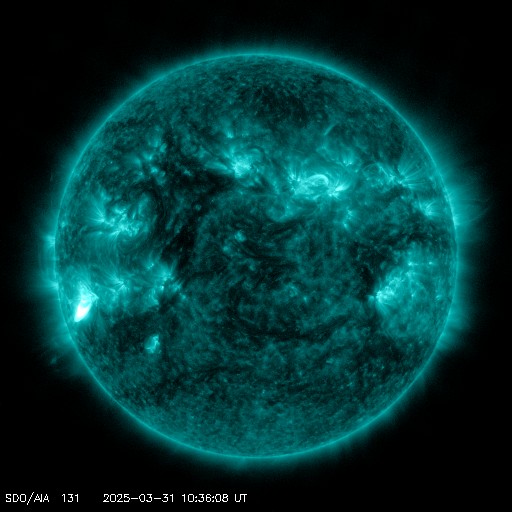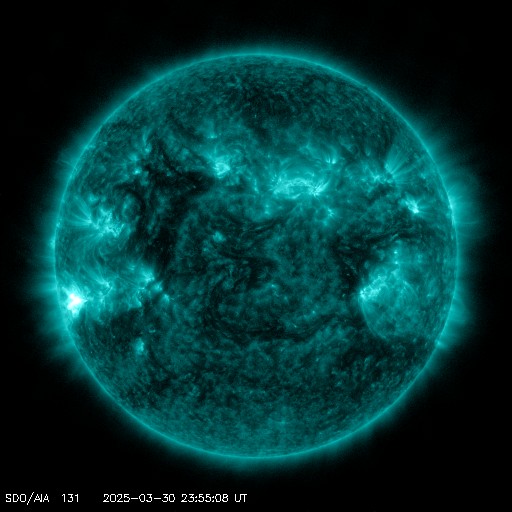Viewing archive of Thursday, 17 July 2003
Solar activity report
Any mentioned solar flare in this report has a scaling factor applied by the Space Weather Prediction Center (SWPC). Because of the SWPC scaling factor, solar flares are reported as 42% smaller than for the science quality data. The scaling factor has been removed from our archived solar flare data to reflect the true physical units.
Report of Solar-Geophysical Activity 2003 Jul 17 2200 UTCPrepared by the NOAA © SWPC and processed by SpaceWeatherLive.com
Joint USAF/NOAA Report of Solar and Geophysical Activity
SDF Number 198 Issued at 2200Z on 17 Jul 2003IA. Analysis of Solar Active Regions and Activity from 16-2100Z to 17-2100Z
Solar activity was low. Today's activity consisted of
numerous C-class flares. The largest of these was a C9/1n at 0823
UTC from Region 412 (N16E05), which was also accompanied by type II
and type IV radio sweeps. Region 412 has shown steady growth with
the emergence of new magnetic flux during the past 24 hours. Region
410 (S12E12) also showed steady growth and was the only other source
for C-class flares. Region 410 has some mixed magnetic polarities
and could develop a delta magnetic configuration. Region 409
(N16E27) continues to be the largest region on the disk but
continues to show decline and simplification. New Region 414
(S02E71) rotated into view today.
IB. Solar Activity Forecast
Solar activity is expected to be
mostly low but there is a chance for an isolated M-class event over
the next three days, with regions 409, 410, and 412 the most likely
sources.
IIA. Geophysical Activity Summary 16-2100Z to 17-2100Z
The geomagnetic field ranged from unsettled to minor storm levels
during the past 24 hours. Today's solar wind continues to show the
presence of a high-speed coronal hole solar wind stream. The greater
than 2 MeV electron fluxes reached high levels during the past 24
hours.
IIB. Geophysical Activity Forecast
The geomagnetic field is
expected to be mostly unsettled with a few isolated active periods
for the next two days. Unsettled to active levels are expected for
the third day. The increase on day three may occur as a possible
response to activity associated with today's C9 flare event.
III. Event Probabilities 18 Jul to 20 Jul
| Class M | 45% | 45% | 45% |
| Class X | 05% | 05% | 05% |
| Proton | 05% | 05% | 05% |
| PCAF | green | ||
IV. Penticton 10.7 cm Flux
Observed 17 Jul 139 Predicted 18 Jul-20 Jul 140/135/140 90 Day Mean 17 Jul 126
V. Geomagnetic A Indices
Observed Afr/Ap 16 Jul 023/048 Estimated Afr/Ap 17 Jul 020/020 Predicted Afr/Ap 18 Jul-20 Jul 015/012-015/015-015/020
VI. Geomagnetic Activity Probabilities 18 Jul to 20 Jul
| A. Middle Latitudes | |||
|---|---|---|---|
| Active | 45% | 45% | 45% |
| Minor storm | 20% | 20% | 20% |
| Major-severe storm | 05% | 05% | 05% |
| B. High Latitudes | |||
|---|---|---|---|
| Active | 35% | 35% | 35% |
| Minor storm | 20% | 20% | 20% |
| Major-severe storm | 10% | 10% | 10% |
All times in UTC
Current data suggests there is a slight possibility for aurora to appear at the following high latitude regions in the near future
Whitehorse, YTAnchorage, AK, Fairbanks, AK, Juneau, AK, Utqiagvik, AK
Latest news
Latest forum messages
Unspecified geomagnetic activity 2147AR4048 38AR4046 136Solar Demon 3Aurora photography hints for those of us with smartphones 54
More topicsSupport SpaceWeatherLive.com!
A lot of people come to SpaceWeatherLive to follow the Sun's activity or if there is aurora to be seen, but with more traffic comes higher server costs. Consider a donation if you enjoy SpaceWeatherLive so we can keep the website online!

Latest alerts
11:15 UTC - Solar protons
Minor S1 Solar Radiation Storm - Minor impacts on HF radio through polar regions
10:45 UTC - Solar flare
Moderate M1.26 flare
10:27 UTC - Radio Blackout
Minor R1 radio blackout in progress (≥M1 - current: M1.22)
00:09 UTC - Solar flare
Moderate M1.03 flare
Sunday, 30 March 2025
23:51 UTC - Radio Blackout
Minor R1 radio blackout in progress (≥M1 - current: M1.03)
Space weather facts
| Last X-flare | 2025/03/28 | X1.1 |
| Last M-flare | 2025/03/30 | M1.0 |
| Last geomagnetic storm | 2025/03/27 | Kp5 (G1) |
| Spotless days | |
|---|---|
| Last spotless day | 2022/06/08 |
| Monthly mean Sunspot Number | |
|---|---|
| February 2025 | 154.6 +17.6 |
| March 2025 | 127 -27.6 |
| Last 30 days | 127 -25.7 |




